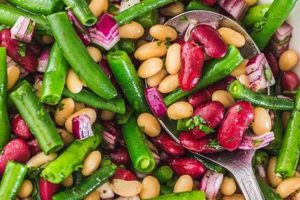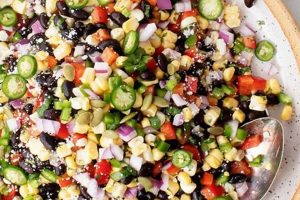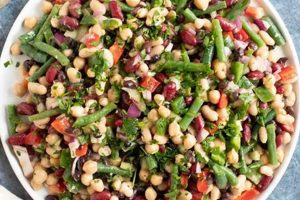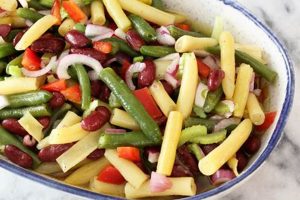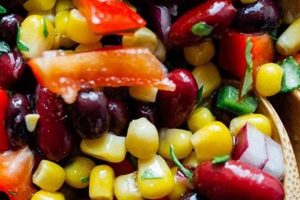A dish combining cooked quinoa, black beans, and various other ingredients like chopped vegetables, herbs, and a dressing creates a nutritious and flavorful meal or side. A typical preparation involves cooking quinoa according to package directions, then combining it with canned or cooked black beans. Additions might include corn, bell peppers, red onion, cilantro, and a lime-based vinaigrette. This dish offers a versatile base, adaptable to individual preferences with ingredients like diced avocado, roasted sweet potatoes, or crumbled feta cheese.
This type of salad provides a complete protein source, combining the essential amino acids found in quinoa and beans. It is also rich in fiber, promoting digestive health and satiety. Furthermore, it offers an array of vitamins and minerals, contributing to a balanced diet. Its adaptability to different palates and dietary restrictions, from vegan and gluten-free to specific allergen exclusions, has contributed to its growing popularity as a healthy and convenient meal option. The historical roots likely lie in South American cuisine, given quinoa’s origin in the Andes region, with adaptations and variations emerging globally as culinary trends evolved.
The following sections will explore variations on this basic preparation, offering detailed instructions and nutritional information. Topics covered will include ingredient selection, cooking techniques, dressing options, and tips for meal prepping and storage.
Tips for Quinoa Black Bean Salad Preparation
Optimizing ingredient selection and preparation techniques elevates this simple salad to a culinary delight. The following tips ensure a balanced flavor profile and desirable texture.
Tip 1: Rinse the quinoa. Rinsing quinoa under cold water before cooking removes its natural coating of saponins, which can impart a bitter flavor.
Tip 2: Toast the quinoa (optional). Toasting dry quinoa in a pan before cooking enhances its nutty flavor and adds a pleasant crunch to the salad.
Tip 3: Use fresh herbs. Fresh cilantro, parsley, or mint add brightness and depth of flavor. Dried herbs can be substituted if necessary, but use a smaller quantity.
Tip 4: Balance the dressing. A vinaigrette with a balance of acidity, sweetness, and salt complements the earthy flavors of quinoa and black beans. Lime juice, red wine vinegar, or a combination work well.
Tip 5: Don’t overcook the quinoa. Overcooked quinoa becomes mushy. Cook just until the grains are tender and the liquid is absorbed.
Tip 6: Add variety with vegetables. Incorporate a variety of colorful vegetables, such as diced bell peppers, chopped red onion, or halved cherry tomatoes, for added texture, flavor, and nutrients.
Tip 7: Consider roasted vegetables. Roasted sweet potatoes, corn, or Brussels sprouts add a smoky depth and satisfying texture.
Employing these tips ensures a flavorful and well-balanced salad, maximizing both nutritional value and culinary enjoyment.
Following these guidelines, one can consistently produce a satisfying and nutritious dish, adaptable to individual preferences and dietary needs. The subsequent section will offer various recipe variations, demonstrating the versatility of this culinary staple.
1. Ingredient Quality
Ingredient quality significantly impacts the overall success of a quinoa black bean salad. The inherent flavors of the core componentsquinoa, black beans, and chosen vegetablesare best showcased when using fresh, high-quality ingredients. For instance, using dried black beans that have been properly soaked and cooked, rather than canned beans, often results in a superior texture and richer flavor. Similarly, selecting ripe, in-season produce elevates the salad’s flavor profile and nutritional value. Substandard ingredients, such as wilted herbs or stale spices, can detract from the final dish, resulting in a less satisfying culinary experience.
The impact extends beyond flavor. Fresh, high-quality ingredients contribute to the salad’s visual appeal. Vibrant, colorful vegetables enhance presentation, making the dish more enticing. Furthermore, ingredient quality directly correlates with nutritional content. Fresh produce retains more vitamins and minerals compared to older, less vibrant counterparts. Choosing organic ingredients minimizes exposure to pesticides and herbicides. Sourcing ingredients locally supports sustainable agriculture and often results in fresher, more flavorful options.
Prioritizing ingredient quality is a crucial step in creating a truly exceptional quinoa black bean salad. While convenience may tempt some to opt for pre-packaged or processed ingredients, the difference in taste, texture, and nutritional value is often substantial. Investing in high-quality components elevates this simple dish from a basic meal to a culinary experience. Careful selection and proper storage of ingredients contribute not only to a more flavorful and visually appealing salad but also to a healthier and more satisfying meal.
2. Flavor Balance
Flavor balance is paramount in a successful quinoa black bean salad recipe. Achieving a harmonious blend of tastes elevates this simple dish, transforming it from merely nutritious to genuinely enjoyable. A well-balanced salad avoids extremes, ensuring no single flavor dominates. It requires careful consideration of each ingredient’s contribution and how these flavors interact to create a unified and pleasing whole.
- Acidity
Acidity provides brightness and cuts through the richness of the quinoa and beans. Common sources include lime juice, red wine vinegar, or lemon juice. Too much acidity can make the salad sharp and unpleasant, while too little can leave it tasting bland. The right balance enlivens the other flavors without overpowering them. For example, a lime-based vinaigrette complements the earthy notes of quinoa and black beans, creating a refreshing counterpoint.
- Saltiness
Salt enhances the inherent flavors of the other ingredients and provides a foundational savory element. It is crucial to season the salad adequately, but over-salting can easily ruin the dish. Sea salt or kosher salt are generally preferred for their clean flavor. Tasting and adjusting seasoning throughout the preparation process is essential to achieving the desired balance. Salting the cooking water for the quinoa contributes to well-seasoned grains from the outset.
- Sweetness (optional)
A touch of sweetness can add complexity and round out the flavor profile. This can be achieved through ingredients like roasted sweet potatoes, corn, or a drizzle of honey or maple syrup in the dressing. Sweetness should be used judiciously, as too much can make the salad cloying. A small amount of sweetness can balance the acidity and enhance the overall complexity. For instance, roasted corn introduces a subtle sweetness that complements a lime vinaigrette and adds textural contrast.
- Spices and Herbs
Spices and herbs introduce aromatic complexity and depth of flavor. Cumin, chili powder, or smoked paprika can add warmth and earthiness, while fresh cilantro, parsley, or mint provide brightness and freshness. The choice of spices and herbs should complement the other ingredients and contribute to the overall balance. Fresh cilantro adds a bright, citrusy note that complements the earthy flavors of quinoa and black beans, creating a well-rounded flavor profile.
A successful quinoa black bean salad hinges on the harmonious interplay of these flavor elements. Careful consideration of each component’s contribution, combined with thoughtful tasting and adjustment, results in a balanced and satisfying dish. Achieving this balance elevates the salad from a simple combination of ingredients to a flavorful and enjoyable culinary creation.
3. Texture Variations
Texture variations play a crucial role in the overall enjoyment of a quinoa black bean salad. A dynamic interplay of textures elevates the sensory experience, preventing monotony and adding interest to each bite. This diversity can be achieved through several methods, each contributing a unique textural element to the final dish. Consideration of texture is essential during ingredient selection and preparation.
The inherent textures of the core ingredients provide a foundation. Quinoa offers a light, fluffy texture with a slight chewiness. Black beans contribute a creamy, smooth contrast. Building upon this base, one can introduce a range of textures through the addition of other components. Chopped raw vegetables, such as bell peppers, onions, and tomatoes, provide crispness and juiciness. Roasted vegetables, like sweet potatoes or corn, offer a tender interior and slightly caramelized exterior. Nuts and seeds, such as toasted pepitas or slivered almonds, introduce crunch and a satisfying bite. Toasted quinoa itself adds a subtle crispness to the overall texture.
The interplay of these contrasting textures creates a more engaging and satisfying culinary experience. A salad consisting solely of soft textures can feel heavy and monotonous. The introduction of crunchy elements, like toasted nuts or raw vegetables, adds a refreshing counterpoint. Similarly, incorporating creamy components, such as avocado or a smooth dressing, balances the chewiness of the quinoa and the firmness of the beans. Achieving a harmonious blend of textures enhances the overall enjoyment and perceived complexity of the salad. This careful consideration of texture transforms a simple salad into a multi-dimensional culinary creation.
4. Nutritional Value
Nutritional value represents a significant benefit of incorporating quinoa black bean salad into one’s diet. This dish offers a dense array of essential nutrients, contributing to overall health and well-being. Understanding its nutritional composition provides insight into its role as a valuable dietary component.
- Complete Protein Source
Quinoa, unlike most plant-based proteins, is a complete protein, meaning it contains all nine essential amino acids the body cannot produce on its own. Combining quinoa with black beans further enhances the protein profile, creating a synergistic effect. This makes the salad an excellent choice for vegetarians, vegans, and anyone seeking to increase their protein intake. Adequate protein intake supports muscle growth, tissue repair, and various other bodily functions.
- High Fiber Content
Both quinoa and black beans are excellent sources of dietary fiber. Fiber promotes digestive health, aids in regulating blood sugar levels, and contributes to feelings of satiety, which can assist in weight management. A high-fiber diet is associated with reduced risk of chronic diseases, including heart disease and type 2 diabetes.
- Micronutrient Density
This salad provides a wide range of micronutrients, including iron, magnesium, folate, and various antioxidants. Iron is essential for oxygen transport, magnesium supports muscle and nerve function, and folate plays a critical role in cell growth and development. Antioxidants protect cells from damage caused by free radicals. The specific micronutrient content can vary depending on the additional ingredients included in the salad, such as bell peppers, which are rich in vitamin C.
- Low Glycemic Index
Quinoa has a relatively low glycemic index (GI), meaning it causes a slower rise in blood sugar levels compared to high-GI foods. This makes it a suitable choice for individuals with diabetes or those seeking to manage their blood sugar levels. Combining quinoa with other low-GI foods, such as black beans and non-starchy vegetables, further contributes to a balanced glycemic load.
The combined nutritional benefits of quinoa and black beans, amplified by the inclusion of various vegetables and a balanced dressing, make this salad a nutrient-rich meal option. Its versatility allows for customization based on individual dietary needs and preferences, further enhancing its value as a healthy and satisfying dish. Regular consumption of this salad, as part of a balanced diet, can contribute significantly to overall nutritional well-being.
5. Preparation Methods
Preparation methods significantly influence the final outcome of a quinoa black bean salad. Proper techniques ensure optimal flavor, texture, and nutritional value. From rinsing the quinoa to incorporating the dressing, each step contributes to the overall quality of the dish. A comprehensive understanding of these methods is essential for consistently producing a successful salad.
- Quinoa Cooking
Proper quinoa cooking is fundamental. Rinsing the quinoa before cooking removes saponins, which can impart a bitter taste. The quinoa should be cooked according to package directions, typically using a 2:1 ratio of water to quinoa. Overcooking results in a mushy texture, while undercooking yields a hard, unpleasant chew. Properly cooked quinoa is light, fluffy, and tender. This provides the optimal base for the salad.
- Bean Preparation
Beans can be prepared from dried form or used from a can. Dried beans require soaking and cooking, while canned beans require rinsing to remove excess sodium. If cooking dried beans, ensuring they are fully cooked yet retain their shape is crucial for the salad’s texture. Proper bean preparation contributes to the overall flavor and texture profile of the dish.
- Vegetable Incorporation
The manner in which vegetables are incorporated impacts both flavor and texture. Raw vegetables, such as diced bell peppers or chopped red onion, offer crispness and a fresh element. Roasting vegetables, like sweet potatoes or corn, brings out their natural sweetness and adds a depth of flavor along with a softer texture. The choice of preparation method depends on the desired outcome and the specific vegetables used.
- Dressing Emulsification and Incorporation
Creating a stable emulsion for the vinaigrette ensures even flavor distribution. Whisking together oil, acid, and seasonings creates a cohesive dressing that coats the other ingredients effectively. The timing of dressing incorporation also plays a role. Adding the dressing too early can make the salad soggy, while adding it too late can result in uneven flavor distribution. The ideal approach involves adding the dressing shortly before serving, allowing the flavors to meld without compromising texture. This ensures that the salad is flavorful and well-balanced.
Mastery of these preparation methods elevates the quinoa black bean salad from a simple assembly of ingredients to a carefully constructed dish with optimal flavor, texture, and nutritional value. Attention to detail in each step ensures a consistently satisfying and wholesome culinary experience. Understanding these techniques empowers individuals to create a dish that highlights the individual components while achieving a harmonious blend of flavors and textures.
6. Serving Suggestions
Serving suggestions enhance the versatility and enjoyment of a quinoa black bean salad recipe. While delicious as a standalone dish, thoughtful serving suggestions broaden its culinary applications, transforming it from a simple salad into a component of a more complex meal. These suggestions offer guidance on how to incorporate the salad into various dining scenarios, maximizing its potential and appealing to a wider range of palates and dietary preferences.
Consideration of complementary flavors and textures is key when developing serving suggestions. The salad’s inherent earthiness and slightly nutty flavor profile pairs well with a variety of proteins, such as grilled chicken or fish. The lightness of the quinoa and the heartiness of the beans create a balanced foundation that can support richer flavors. For example, serving the salad alongside grilled salmon with a lemon-herb marinade creates a harmonious balance of flavors and textures. The richness of the salmon complements the earthiness of the salad, while the acidity of the marinade enhances the overall brightness of the dish. Alternatively, serving the salad as a filling for tacos or burritos introduces a different textural element and expands its role beyond a side dish.
Serving suggestions also cater to diverse dietary needs. Highlighting vegan or gluten-free options broadens the salad’s appeal. For instance, suggesting a tahini-based dressing instead of a dairy-based one creates a vegan-friendly option. Emphasizing the salad’s gluten-free nature expands its suitability for individuals with gluten sensitivities. Furthermore, serving suggestions can address portion control and meal planning. Suggesting the salad as a component of a larger meal, such as a Buddha bowl with roasted vegetables and a protein source, provides a balanced and complete meal option. Offering portion size recommendations helps individuals manage calorie intake and integrate the salad into a healthy eating plan. Thoughtful serving suggestions elevate the quinoa black bean salad from a simple recipe to a versatile culinary tool, adaptable to diverse tastes and dietary requirements.
Frequently Asked Questions
This section addresses common inquiries regarding quinoa black bean salad preparation and consumption.
Question 1: How long can this salad be stored in the refrigerator?
Properly stored in an airtight container, the salad typically lasts for 3-5 days in the refrigerator. Consuming it within this timeframe ensures optimal quality and minimizes the risk of spoilage. Discarding any salad left at room temperature for more than two hours is recommended.
Question 2: Can this salad be frozen?
While freezing is possible, it is generally not recommended. Freezing can alter the texture of the vegetables, making them mushy upon thawing. The dressing may also separate, impacting the overall quality and enjoyment of the salad.
Question 3: What are suitable alternatives to lime juice in the dressing?
Lemon juice or red wine vinegar offer suitable alternatives to lime juice, providing the necessary acidity to balance the flavors. Other options include apple cider vinegar or white wine vinegar, though these may impart a slightly different flavor profile.
Question 4: Can other grains be substituted for quinoa?
While quinoa offers unique nutritional benefits, other grains like couscous, farro, or brown rice can be substituted. However, these substitutions may alter the overall flavor and texture of the salad.
Question 5: How can sodium content be reduced when using canned beans?
Thoroughly rinsing canned beans under cold water significantly reduces sodium content. This step removes excess salt and contributes to a healthier final dish. Opting for low-sodium or no-salt-added canned beans provides an additional means of sodium reduction.
Question 6: How can this salad be adapted for different dietary restrictions?
Adaptations for various dietary restrictions are easily implemented. For gluten-free diets, ensuring all ingredients, including dressings and seasonings, are certified gluten-free is crucial. Vegan adaptations involve omitting any animal products, such as cheese or honey, and using plant-based alternatives. Specific allergen considerations require careful ingredient selection and preparation to avoid cross-contamination.
Understanding these common inquiries facilitates successful preparation and enjoyment of this versatile and nutritious dish. Careful attention to ingredient selection, preparation methods, and storage guidelines ensures optimal flavor, texture, and nutritional value.
The following section will explore various recipe variations, highlighting the adaptability of this culinary staple.
Recipe Quinoa Black Bean Salad
Exploration of recipe quinoa black bean salad reveals a dish offering notable versatility and nutritional density. From ingredient selection and preparation methods to flavor balancing and serving suggestions, careful consideration of each element contributes to a successful outcome. Prioritizing ingredient quality maximizes flavor and nutritional value. Balancing acidity, saltiness, and optional sweetness enhances the overall flavor profile. Textural variations, achieved through incorporating diverse ingredients and preparation techniques, elevate the sensory experience. Nutritional analysis highlights the dish’s role as a complete protein source, rich in fiber and essential micronutrients. Understanding preparation methods, including proper quinoa cooking and bean preparation, ensures optimal texture and flavor. Serving suggestions broaden the dish’s culinary applications, adapting it to diverse palates and dietary needs. Addressing frequently asked questions provides practical guidance for successful preparation and storage. Recipe quinoa black bean salad represents a versatile and nutritious culinary option adaptable to individual preferences and dietary requirements.
Culinary exploration beyond the basic recipe quinoa black bean salad encourages creativity and personalization. Experimentation with diverse ingredients, flavors, and textures expands culinary horizons and enhances appreciation for this adaptable dish. Continued exploration of culinary techniques and nutritional understanding elevates everyday meals to opportunities for both nourishment and enjoyment. Recipe quinoa black bean salad serves as a foundation upon which culinary creativity and nutritional awareness can flourish.

